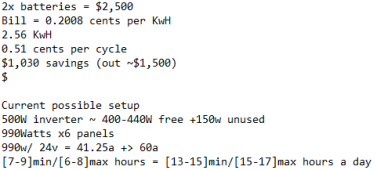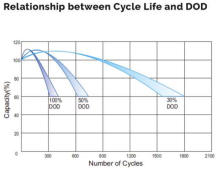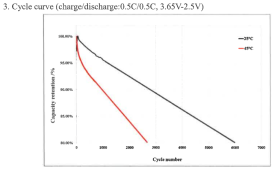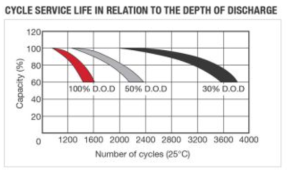Hello, im looking for some feedback if its cost effective purchasing 2x batteries (them alone) compared to if i just paid my electricity bill.
A few points are:
- I dont have batteries
- no fuses/breakers
- no charge controller
- I pay ~$0.2 per Kw/h
- I do have spare solar pannels
My friend and i have dont some looking around for batteries from physical store (you can walk into) As we think this will be better if anything was to go wrong with the batteries, thered be more of a store than a online held desk. The overal goal is to run my PC on these batteries to slowly cut back our power bill as well as begin a hobby.
For the picture below we have 2 batteries costing $2500 ($1250 each) 12.8V 200Ah upping to 25.6v (24v) 200Ah
Fulling draining the battery each day says we get ~2000 cycles coming to $0.51 Per cycle = $1,020 or with help of a solar pannel and charge controller while limmiting myself to ~50% drain i get ~5000 cycles which = $2,550 that covers the batteries. Would this be worth as a 'hobby' side of things? The charge controller i need (from what victron says) is another $700-800.

My Pc runs at ~300Watts with 2 screens included, i have never seen it over. With that the running time we calculated is between 7-8 hours without solar and up to 13-17 hours with solar providing the solar pannels can charge and run my pc at the same time. I do use my computer for those hours each day.
A few points are:
- I dont have batteries
- no fuses/breakers
- no charge controller
- I pay ~$0.2 per Kw/h
- I do have spare solar pannels
My friend and i have dont some looking around for batteries from physical store (you can walk into) As we think this will be better if anything was to go wrong with the batteries, thered be more of a store than a online held desk. The overal goal is to run my PC on these batteries to slowly cut back our power bill as well as begin a hobby.
For the picture below we have 2 batteries costing $2500 ($1250 each) 12.8V 200Ah upping to 25.6v (24v) 200Ah
Fulling draining the battery each day says we get ~2000 cycles coming to $0.51 Per cycle = $1,020 or with help of a solar pannel and charge controller while limmiting myself to ~50% drain i get ~5000 cycles which = $2,550 that covers the batteries. Would this be worth as a 'hobby' side of things? The charge controller i need (from what victron says) is another $700-800.

My Pc runs at ~300Watts with 2 screens included, i have never seen it over. With that the running time we calculated is between 7-8 hours without solar and up to 13-17 hours with solar providing the solar pannels can charge and run my pc at the same time. I do use my computer for those hours each day.





